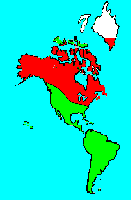SPECIES INFO
Lake quillwort (Isotes macrospora) is found from Labrador west to the Northwest Territories of Canada. This can be found as far south as New England and New Jersey. This is a submerged species that can be found on banks in dry seasons. There are 10-30 rigid leaves, usually from 2 to 6 inches in height. The dark green or olive green leaves are quadrangular in cross section.Quillworts (Family Isoetaceae) are a group of primitive plants that grow along shorelines of primarily freshwater (sometimes brackish) lakes, ponds, rivers, and streams. This is the only family in the order Isoetales.
Quillworts (Order Isoetales) are a group of primitive plants that grow along shorelines of primarily freshwater (sometimes brackish) lakes, ponds, rivers, and streams. This is the only order in the class Isoetinae.
Quillworts (Class Isoetinae) are a group of primitive plants that grow along shorelines of primarily freshwater (sometimes brackish) lakes, ponds, rivers, and streams. Some species are totally submerged; some are partially submerged; others are terrestrial. Because they appear so much like grasses and sedges, they are frequently overlooked.
Quillworts comprise about 70-80 species of worldwide plants that are generally absent from the tropics. There are about 26 species in the United States, with seven of those being found in the northeastern United States. Thirteen species are figured and discussed in the original Brown and Britton "Flora of the Northern United States." `They generally are rare or absent in the midwestern United States.
Fern Phylum (Pteridophyta) is a large group of primarily tropical plants that typically reproduce by a complicated process involving spores. There are typically two different generations involved in the reproductive process.
Although Ferns have vascular tissue, they are separated from the seed plants in that ferns grow directly from the fertilized zygote. There are probably over 9,000 species in this group worldwide. In prehistoric times, this phylum was the predominant plant phylum on earth. Most of the coal and oil used for energy today derives from this phylum.
Although they are still numerous in moist areas, ferns have generally been replaced by seed plants. Most ferns are small to medium-sized plants. However, there are tree ferns in the tropics.
The Fern phylum is divided into several classes including:
Horsetails - Class Articulate or Class Equisetinae
Club Mosses - Class Lycopodiinae
Psilotes - Psilotinae Class
Quillworts - Class Isoetinae
Ferns - Class Filicinae
The first four classes are very primitive when compared to the last or fern class. Some authors have suggested that the fern class is more closely related to the seed plants than the first four classes.
Kartesz finds 27 different families in the Pteridophyta. He finds 893 full species growing in greater North America, including Hawaii, Puerto Rico, the Virgin Islands, and Greenland.
Plant kingdom contains a large variety of different organisms including mosses, ferns, and seed plants. Most plants manufacture their energy from sunlight and water. Identification of many species is difficult in that most individual plants have characteristics that have variables based on soil moisture, soil chemistry, and sunlight.
Because of the difficulty in learning and identifying different plant groups, specialists have emerged that study only a limited group of plants. These specialists revise the taxonomy and give us detailed descriptions and ranges of the various species. Their results are published in technical journals and written with highly specialized words that apply to a specific group.
On the other hand, there are the nature publishers. These people and companies undertake the challenging task of trying to provide easy to use pictures and descriptions to identify those species.

